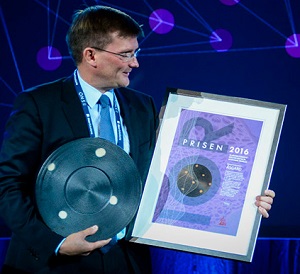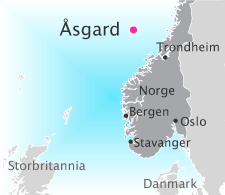Acclaim for ?sgard
The Norwegian Petroleum Directorate (NPD) has awarded its improved oil recovery prize for 2016 to the licensees of the Åsgard field in the Norwegian Sea for their subsea wet gas compressor.
This will yield almost 50 million cubic meters (306 million barrels of oil equivalent) in additional gas and condensate.
According to the citation, the solution on Åsgard is the result of a long-standing commitment by ambitious leadership and enthusiastic engineers. The licensees – Statoil (operator), Petoro, Eni, Total and ExxonMobil – have demonstrated the stamina to follow through all the way from initial concept to decision and implementation.
Operational from October 6, 2015, the compressor is the first of its kind in the world. It stands in 300 meters (984 feet) of water and covers an area similar to a football pitch. Gas is recovered from reservoirs 2,500 meters (8,200 feet) beneath the seabed.
 Gas compression is one of Statoil’s key measures to provide higher and profitable volumes on existing NCS fields, says head of Åsgard operations, Halvor Engebretsen, who received the prize on behalf of the other licensees.
Gas compression is one of Statoil’s key measures to provide higher and profitable volumes on existing NCS fields, says head of Åsgard operations, Halvor Engebretsen, who received the prize on behalf of the other licensees.
Åsgard subsea gas compression is the world’s first and one of Statoil’s most radical innovation projects, he says. This technology represents a quantum jump that may contribute to major improvements in both the recovery rate and lifetime for a number of gas fields. In close collaboration with suppliers such as Aker Solutions, MAN and Technip, Statoil has qualified more than 40 new technologies.
The idea was born more than 20 years ago. Testing of subsea installations on Draugen, Troll, Tordis and Tyrihans in 1994-2009 were necessary moves towards the realization of this step-changing technology.
Its development was pursued in a close collaboration between the oil companies and a number of suppliers who have competed for the contracts.
“Achieving such interaction is perhaps especially important today,” NPD director general Bente Nyland said when presenting the prize during a conference in Stavanger. “So is keeping world-class, dynamic engineering clusters.”
She said the industry that it must not cut costs so much that it becomes impossible for Norway’s oil and gas industry to continuing making world-class technological advances. The NPD would challenge more players to achieve such a collaboration.
The Åsgard subsea compression technology not only represents an important contribution for improving recovery from that field, but also provides opportunities to recover more oil and gas from other reservoirs. Subsea processing, and gas compression in particular, could make it easier to develop discoveries in deep water and in areas far from existing infrastructure.
Using this technology on Åsgard is expected to yield 49 million cubic meters in additional gas and condensate from the Midgard and Mikkel reservoirs. The recovery factor is expected to rise from 71 to 86 percent for the former, and from 46 to 68 percent for the latter.
In a comment on the prize, Nyland points out that recovering all commercial resources is part of the each licensee’s work commitment: “That naturally involves risk, and we therefore acclaim technology development and pilot projects. “When we see that these succeed, as has been the case with Åsgard, we must recognize the inventiveness and boldness displayed by the companies. They have taken an investment risk, and can now reap the reward.”
She believes that such a project would have been more difficult to launch with today’s cost and oil price regime. “This shows that the profitability of a field is determined when it ceases production, and not by current oil and gas prices.”
 The project has been demanding. Statoil began testing in the K-lab at Kårstø as early as 2008, when it tried out a full-scale model underwater. The most important qualification areas have been power supply for the compressors, the compressor motors and the control systems. Development of the installations system for the modules has also been a key area.
The project has been demanding. Statoil began testing in the K-lab at Kårstø as early as 2008, when it tried out a full-scale model underwater. The most important qualification areas have been power supply for the compressors, the compressor motors and the control systems. Development of the installations system for the modules has also been a key area.
Åsgard is located on the Halten Bank in the Norwegian Sea, around 200 kilometers (124 miles) off mid-Norway and 50 kilometers (31 miles) south of the Heidrun field.

that matters most
Get the latest maritime news delivered to your inbox daily.
The Åsgard A oil production vessel started production in May 1999. Åsgard B is a semi-submersible gas and condensate processing platform, which came on stream in October 2000. Åsgard C is a condensate storage vessel tied back to the field.
The entire Åsgard field development ranks among the largest developments on the Norwegian Continental Shelf, embracing a total of 63 production and injection wells drilled through 19 subsea templates.
